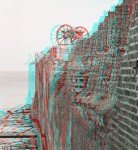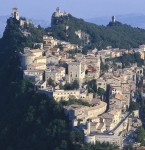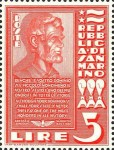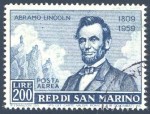 One hundred and fifty years ago today, at 4:30 in the morning, Captain James fired a shell from a ten-inch mortar across Charleston harbor at Fort Sumter. The garrison had been running desperately low on supplies, and since South Carolina had been the first state to formally secede from the Union months before (on Christmas Eve, 1860, in reaction to the election of Abraham Lincoln), Union troops weren’t going to be able to just waltz into Charleston and buy what they needed. Lincoln ordered a relief expedition and so informed the governor of South Carolina.
One hundred and fifty years ago today, at 4:30 in the morning, Captain James fired a shell from a ten-inch mortar across Charleston harbor at Fort Sumter. The garrison had been running desperately low on supplies, and since South Carolina had been the first state to formally secede from the Union months before (on Christmas Eve, 1860, in reaction to the election of Abraham Lincoln), Union troops weren’t going to be able to just waltz into Charleston and buy what they needed. Lincoln ordered a relief expedition and so informed the governor of South Carolina.
Confederate commander General P.G.T. Beauregard decided the fort had to be abandoned before the relief came. He demanded that the garrison surrender Fort Sumter or be fired upon. U.S. Army Major Robert Anderson, Fort Sumter’s commanding officer, offered to leave on April 15th, but only if relief didn’t arrive first and if he did not receive orders contradicting the plan. Beauregard did not accept and notified him in return that they would open fire an hour from that time and so they did. It was all very civilized and officer-and-a-gentlemanly. Anderson had been Beauregard’s artillery instructor at West Point 30 years earlier.
 Confederate batteries fired for 34 hours straight. Fort Sumter returned fire at 7:00 A.M., but to no avail. The fort was surrendered and the garrison evacuated on April 13th. Major Anderson lowered the Union flag on April 14th, the day of his official surrender, and took it with him to New York. The flag would be used as a patriotic rallying symbol in the North for the duration of the war. It was auctioned off regularly to raise money for the war effort, with the expectation that everyone who “bought” it would immediately return it so it could be auctioned again. On April 14, 1865, Major General Anderson raised the flag over Fort Sumter again, in celebration of the end of the war. That same night, Abraham Lincoln went to the theater and never returned.
Confederate batteries fired for 34 hours straight. Fort Sumter returned fire at 7:00 A.M., but to no avail. The fort was surrendered and the garrison evacuated on April 13th. Major Anderson lowered the Union flag on April 14th, the day of his official surrender, and took it with him to New York. The flag would be used as a patriotic rallying symbol in the North for the duration of the war. It was auctioned off regularly to raise money for the war effort, with the expectation that everyone who “bought” it would immediately return it so it could be auctioned again. On April 14, 1865, Major General Anderson raised the flag over Fort Sumter again, in celebration of the end of the war. That same night, Abraham Lincoln went to the theater and never returned.
There were no Union nor Confederate fatalities in the first battle for Fort Sumter, although two Union soldiers and one Confederate died from their own misfires. The fort was not so lucky. It was ruined by the heavy shelling and ruined even harder two years later when the Union barraged Charleston from the water. It would be partially rebuilt by the US Army after the war and is now a national monument, along with the Fort Sumter Visitor Education Center in Charleston, and Fort Moultrie on Sullivan’s Island in the harbor.
The National Park Service is commemorating the sesquicentennial with a variety of events and services. Their website is packed with information, not just about Civil War parks and national monuments, but also about the war itself. They have made their entire National Park Civil War Series of books available online for free. If you were to buy the series in print, it would cost you $186, so I suggest you get downloadin’ now while the downloadin’ is good, then make a donation to the NPS and/or volunteer to help preserve our national monuments. (There are 54 national parks related to the Civil War maintained by the NPS. Click “by topic” and “Civil War” on this search page for links to all of them.)
Speaking of preserving history, the Civil War Trust is dedicated to the preservation of Civil War battlefields. To further their goal in the long term, they have put together an impressive group of educational resources so that future generations can grow up to be as properly obsessive about preserving these sites as they are. They have an entire Civil War Curriculum on their website, including freely downloadable lesson plans, exams and in-class presentations for elementary, middle and high school students. There’s a coloring book (pdf), crossword puzzles, links to primary sources, contemporary pictures, maps, and best of all, lessons based on visiting Civil War battlefields.
 Did you know that 70% of the pictures taken during the war were actually shot in 3D for viewing through a stereoscope device? The Civil War Trust also has an extensive collection of digitized stereoview photographs. You can order 3D glasses free of charge from the website. They also have many galleries of period and contemporary non-3D pictures of the battlefields they are working to preserve.
Did you know that 70% of the pictures taken during the war were actually shot in 3D for viewing through a stereoscope device? The Civil War Trust also has an extensive collection of digitized stereoview photographs. You can order 3D glasses free of charge from the website. They also have many galleries of period and contemporary non-3D pictures of the battlefields they are working to preserve.
If you’re planning a trip to Washington, D.C., the Smithsonian has set up a website featuring all the current and upcoming events and exhibits on the occasion of the 150th anniversary of the Civil War. If you’re staying put but would like to learn out more about the Civil War, Smithsonian magazine has reposted articles from their archives about the Civil War in honor of the sesquicentennial.
There are some excellent new pieces as well. Fort Sumter: The Civil War Begins is a good place to start today. Then there’s The Women Who Fought in the Civil War, an interview with author Bonnie Tsui about the hundreds of women who disguised themselves as men to enlist and fight, How We’ve Commemorated the Civil War, a retrospective on how Americans have remembered the Civil War on past milestone anniversaries, and two articles on the first Union officer to die in the fighting, The Death of Colonel Ellsworth and How Col. Ellsworth’s Death Shocked the Union.
In the pictures worth a thousand words category, Smithsonian offers a slideshow of select Civil War artifacts in the Smithsonian museums, and an interactive timeline of the Civil War (click on the question mark icons for more information).
I can’t let a national commemoration pass without a nod to the history nerd paradise that is the Library of Congress. The Last Full Measure: Civil War Photographs from the Liljenquist Family Collection opens today at the Library of Congress. I blogged about the donation of this impressive collection of over 700 ambrotype and tintype portrait photographs of Civil War soldiers and civilians last fall. Now almost the entire collection has been digitized. A selection of about half of the pictures will be part of the exhibit.
You can also read Slave Narratives from the Federal Writers’ Project on the LoC website. The narratives can be browsed by narrator or by state, and the pictures are arranged by topic. There’s a thorough introduction very much worth reading to get an idea of the historical context of the project, its approach to recording of narratives and its limitations.
Preserving the history of slavery is also the mission of National Trust for Historic Preservation program officer Joseph McGill who spends the night in slave dwellings all over the South to publicize the need to preserve slave quarters as well as the big fancy plantation buildings. Since they were constructed out of flimsy materials to begin with, slave dwellings are even more endangered than their architecturally sound contemporaries.
 Finally, if you’ve kept reading this wall of text, here’s a little payoff. After Lincoln’s inauguration in March 1861, he received piles of congratulatory letters. One of them was from the Most Serene Republic of San Marino, the wee little statelet of 24 square miles in the middle of Italy that according to legend was founded in the 4th century A.D. as a monastic community by Marinus, a Christian stonecutter and Deacon. It has retained its sovereignty since then, making it the oldest sovereign nation in the world, and since its constitution (which codified a political system already in place since 1300 or so) was written in 1600, San Marino is also the oldest constitutional republic in the world.
Finally, if you’ve kept reading this wall of text, here’s a little payoff. After Lincoln’s inauguration in March 1861, he received piles of congratulatory letters. One of them was from the Most Serene Republic of San Marino, the wee little statelet of 24 square miles in the middle of Italy that according to legend was founded in the 4th century A.D. as a monastic community by Marinus, a Christian stonecutter and Deacon. It has retained its sovereignty since then, making it the oldest sovereign nation in the world, and since its constitution (which codified a political system already in place since 1300 or so) was written in 1600, San Marino is also the oldest constitutional republic in the world.
Surrounded by an almost-unified Italy in 1861, San Marino was sweating a little when its Capitani Regenti (elected leaders) wrote to Lincoln. The letter expressed solidarity with the Union — six Southern states had already seceded by the time Lincoln was inaugurated — and conferring honorary citizenship on the American president. From the letter:
We have wished to write to you in our own hand and in English, although we have little knowledge and no practice in the language. It is a some while since the Republic of San Marino wishes to make alliance with the United States of America in that manner as it is possible between a great Potency and a very small country. As we think not extention of territories but conformity of opinions to procure friendly relations, so we are sure you will be glad to shake hands with a people who in its smallness and poverty can exhibit to you an antiquity from fourteen centuries of its free government.
Now we must inform you that to give to the United States of America a mark of high consideration and sincere fraternity the Sovereign Counsel on our motion decreed in its sitting of 25th October … that the citizenship of the Republic of San Marino was conferred for ever to the President pro tempore of the United States of America and we are very happy to send you the diploma of it.
We are acquainted from newspapers with political griefs, wich you are now suffering therefore we pray to God to grant you a peaceful solution of your questions. Nevertheless we hope our letter will not reach you disagreeable, and we shall expect anxiously an answer which proves us your kind acceptance.
Secretary of State William Henry Seward personally brought the letter to Lincoln’s attention. After some weeks, the President replied accepting the honorary citizenship and describing the key issue of the war in terms that presage his Gettysburg Address. From Lincoln’s reply:
Although your dominion is small, your State is nevertheless one of the most honored, in all history. It has by its experience demonstrated the truth, so full of encouragement to the friends of Humanity, that Government founded on Republican principles is capable of being so administered as to be secure and enduring.
You have kindly adverted to the trial through which this Republic is now passing. It is one of deep import. It involves the question whether a Representative republic, extended and aggrandized so much as to be safe against foreign enemies can save itself from the dangers of domestic faction. I have faith in a good result.
Abraham Lincoln’s letter is now one of San Marino’s most treasured historical artifacts. It is on display in the National Museum. In 1937, San Marino issued an Abraham Lincoln stamp, quoting the “most honored” line. They also dedicated a bronze sculpture to him, and the letter was read aloud at the ceremony inaugurating the bust. It was the first time in history Lincoln appeared on a foreign stamp. In 1959, they issued another set of Abraham Lincoln stamps, this time in honor of the sesquicentennial of his birth. Abramo Lincoln looms large in little San Marino.



Truly one of the most sad and yet fascinating periods in American history.
Indeed. The next 4 years will see a great many special events dedicated to the sesquicentennial.
Four years of my grumpiness will now ensue.
:angry:
At least you live out Pacific-way. Count your blessings!
A number of years ago I visited the battlefield at Fredericksburg, Virgina. In some ways like Picket’s charge at Gettysburg, it was a case of lambs to the slaughter as the Union ranks attempted to ascend the slopes to the Confederate position. Behind the theatre of carnage now lies the vast panorama of white crosses to the many who fell.
Standing there on the sunken road between the two sites, it is so difficult to imagine such a terrible event.
A few years too late from when the article was first written, and one year too late from the Sesquicentennial of Gettysburgh. I attended those events over the course of those three days of July 1 – July 3 last summer. There were so many moments of silence, and each time a new one came, it was even more emotional than the last.
The speeches they gave during the opening on the 1st of July, together with the sound effects of the cannon fire far off in the warm, darkening mid-summer sky was truly amazing to behold.
There is so many great things about this post, but I think my favorite is President Lincoln’s letter. I also really enjoyed the link on The Women Who Fought in the Civil War. I am going to incorporate both of these into my class next month when I cover the Civil War.